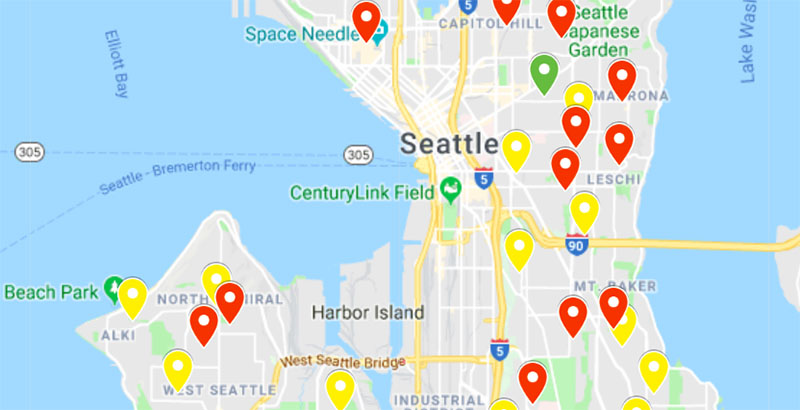Exclusive: How Safe Is My Child at School? New Interactive Map Allows Seattle Parents to Compare Classrooms

Over the past two years, The 74 has published a special series of maps compiled by Max Eden, all looking at the critical information contained in school climate surveys and mapping out responses to those surveys in New York City, Los Angeles and Philadelphia. (Click on the city names to see the maps, and read more about what Eden says he learned in surveying the safety data.) In this latest installment, Eden looks at school safety in Seattle based on surveys of students. NYC, L.A., Philly, and Seattle are among only a small number of major districts that conduct the surveys and make their results public. In a separate essay, Eden argues that all districts should do the same.
Five years ago, facing pressure from a federal Department of Education investigation, Seattle Public Schools launched a policy initiative to curtail school suspensions. Three years ago, the district announced a one-year moratorium on out-of-school suspensions for elementary students and created a districtwide plan to further reduce suspensions in middle and high schools. Last year, Washington state followed suit with a legislative initiative to decrease suspensions statewide.
To discipline-reform advocates, this is great news. But no one stopped to see what Seattle’s students thought about what was happening in their schools as suspensions were dramatically curtailed. Unfortunately, as fits a national pattern, Seattle students say that most of the 102 schools in the district have become less safe, less respectful, and less supportive places to learn.
So long as the district was being pressured by the government to press forward with discipline reform or potentially lose federal funding, student voices mattered little. But now that the 2014 Dear Colleague Letter on school discipline has been rescinded — and that threat has been lifted — there is finally an opportunity for the voices of students, teachers, and parents to be taken seriously.
Seattle Public Schools is one of a small number of major districts that administer an annual, consistent school climate survey, asking students a range of questions and making the results publicly available at the school level. In order to inform the parents of Seattle students — and the general public — about how school climate changed as the district aggressively lowered suspensions, I pulled answers to questions concerning safety, respect, and fairness from the first year that results are available until the latest school year (2015 to 2018).
The graph below looks at how the percentage of students providing favorable answers to a half-dozen questions has changed over the past four years. Schools in blue saw a 15-percentage-point or greater increase in favorable student responses; schools in green saw a 5- to 15-point positive shift; schools in gray saw a shift of less than 5 points in a positive or negative direction; schools in orange saw a 5- to 15-point negative shift; schools in red saw a negative shift of 15 percentage points or greater.

The results are grim. Fewer students at 57 schools said they feel safe in 2018 than in 2015, compared with 10 schools where results improved. Fewer students at 64 schools said students respect adults, compared with 16 schools where respect improved. Fewer students at 69 schools said they were treated fairly, compared with nine where more said so. And fewer students at 59 schools said their fellow students were friendly, compared with 11 where more said so.
To provide parents with at-a-glance insight into their own child’s school and how it has changed, I uploaded the school climate data for all Seattle schools onto a Google Map. The schools are color-coded by the percentage of students who say they feel safe at school: Schools where less than 70 percent of students say they feel safe are labeled red; schools where between 70 and 85 percent of students say they feel safe are labeled yellow; and schools were 85 percent or more students say they feel safe are labeled green. The map provides both the percentage of students who give a favorable response to each question in 2018 and also how that percentage has shifted.
The map provides both the percentage of students who give a favorable response to each question in 2018 and how that percentage has shifted since 2015. For example, at Mercer Middle School, only 59 percent of students feel safe (down 17 percentage points from 2015) and only 28 percent of students say students respect adults (down 23 points from 2015).
Something has clearly gone very wrong in Seattle Public Schools.
My hypothesis is that this deterioration in school climate is a result of the district’s aggressive effort to lower suspensions. It fits perfectly with a pattern of harm documented by students in other districts that have implemented discipline reform, such as New York City, Los Angeles, Washoe County in Nevada, and Pittsburgh. Although the data doesn’t lend itself to an academic analysis that could provide causal certainty, it seems unlikely to be a coincidence that almost everywhere these reforms occur, we have school climate survey data showing that fewer students feel safe, respected, and supported.
But it’s no wonder that — despite having the data at their fingertips — none of these districts have reversed course on discipline reform. District administrators and school board members had strong financial and public relations incentives to lower suspensions. Because discipline reform is framed as an issue of racial justice, school leaders expect positive press coverage for decreasing suspensions. More importantly, school districts, like Seattle, under investigation by the federal government risked losing federal funding and could find relief from that threat only by fully embracing the Obama administration’s preferred policies.
The fact that the feds are no longer pressuring Seattle Public Schools to press forward on discipline reform is a necessary but radically insufficient condition for meaningful change. Social justice activist groups will continue to ignore school climate data, point to suspension data, and declare that “the district, as an institution, does not care about students of color.”
Students — especially students of color — have been telling the community that they’re feeling less safe. But their voices have been effectively silenced by social justice activists and self-interested education bureaucrats who show no signs of reconsidering their policy position in light of mounting evidence of harm.
The only way that children’s voices can be heard is if their parents speak up on their behalf. Seattle parents must examine their school’s climate data, and if the students are saying they feel less safe, talk to the teachers to figure out why. If teachers tell them their hands have been tied by these new policies and that they’re less able to maintain order and safety, then parents must press the school board to repeal them.
Max Eden is a senior fellow at the Manhattan Institute, specializing in education policy.
Get stories like these delivered straight to your inbox. Sign up for The 74 Newsletter

;)
